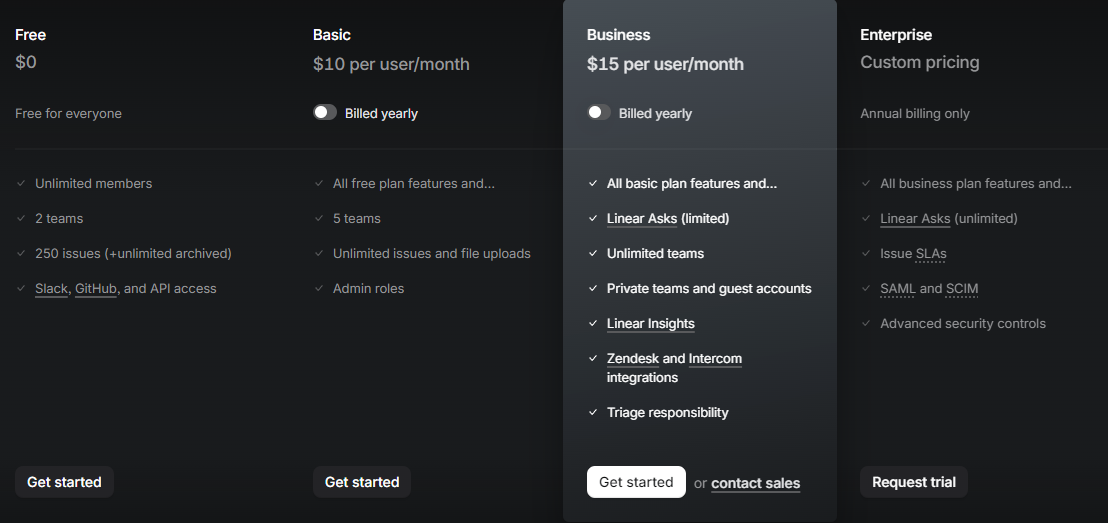The Linear App Vs. Jira: Which Platform Should You Use?
When choosing the perfect tool for your technical team, your options are endless. Some tools may have the popular features you’re after, but they don’t function the way you imagined. Others may run like a dream but might be missing a few of the bells and whistles you had in mind. And sometimes you stumble across a great option but it’s way out of budget.
Linear and Jira are two popular tool options for technical teams. Both are great products, but they have a few differences that may sway you and your team one way or the other. Let’s break down both tools so you can choose which works best.
What is the Linear app?
Linear is a project management tool specifically suited for teams in the issue-tracking space — mostly software development. Linear’s goal is to streamline issues, sprints, and product roadmaps with a streamlined UX (user experience) and top-notch support.
Built for teams of all sizes, from the smallest startups to the largest enterprise players, Linear provides a simple and functional user experience.

What is Jira?
Built by Atlassian, Jira is one of the most popular software management tools in the SaaS (software-as-a-service) space today. Jira allows issue and bug tracking, agile project management, and supports all of the steps in your team’s development lifecycle.
With the power of the Atlassian community, Jira is one of the most accessible software management tools with millions of users to learn from and share with. The platform supports everything from basic everyday tasks to the most complex projects.

Linear vs. Jira: Pricing
Now that we have a basic understanding of a few key differences between Linear and Jira, let’s take a look at the pricing options.
Linear pricing

Linear has four pricing tiers for teams to choose from:
- The Free Plan, which supports two teams and 250 max issues.
- The Basic Plan, at $10 per user per month, supports five teams and unlimited issues.
- The Business Plan, at $15 per user per month, adds Slack automations, built-in integrations, and detailed analytics for unlimited teams.
- The Enterprise Plan, with custom pricing, offers the security, permissions, and reporting enterprise organizations need.
All four plans share some common features like unlimited members and API access.
Jira pricing

Jira offers user-based pricing and offers four tiers to choose from:
- The Free Plan, which offers unlimited tasks, most of Jira’s views, reports and dashboards, automations, and more.
- The Standard Plan, starting at $8.15 per user per month, adds user roles and permissions, more automations, more storage, and customer support.
- The Premium Plan, starting at $16 per user per month, adds built-in AI, cross-team planning, dependency management, and unlimited storage.
- The Enterprise Plan, with custom prices for each plan, adds enterprise-grade access management, admin controls, and more.
When it comes to price, Jira has a more robust free plan, and its Standard plan is cheaper per user, too. That means if your monthly bill is a big priority when picking a platform, Jira will come out ahead.
Linear vs Jira: What do users say?
With long lists of features, glowing testimonials, and persuasive blog articles on each platform’s website, going straight to the source doesn’t always make it an easy choice. Let’s take a look at what some of the actual users are saying about these tools to get the full picture.
Linear
Overwhelmingly, the Linear community raves about the elevated user experience. Aside from Linear being purely functional, many users cite that it’s also fun to use. Here’s more about what users think makes the Linear app stand apart, both positively and negatively.
Pros: Linear offers smart keyboard shortcuts, dark mode, and quick roadmap and product building. Some users say it runs faster than Jira, has a simple design, and is surprisingly easy to use. Linear is designed to empower each user, instead of having them stuck and confused on the support page.
Cons: As far as drawbacks go, users emphasize Linear as a tool mostly fit for engineering and agile teams. If you want a tool that could house your engineering and project management teams, for example, Linear might not be a fit. For example, nesting and multi-homing issues functionality is limited, and it’s not a first-choice tool for big-picture projects.
Jira
Jira is the most popular issue-tracking tool in SaaS. A lot of the Jira community praises it as the standard in engineering tools, and Jira is a great addition to a tool stack already using other tools by Atlassian. Let’s take a look at the feedback from their users.
Pros: Jira users praise the product for having endless functionality. Jira has all of the bells and whistles that engineers need to get their work done but also supports roadmapping, multi-homing, automation, and many other features that business teams are looking for. Jira is highly customizable and the large community makes it easy to find support and answers.
Cons: Because Jira is such a vast, powerful tool, complexity is a large hurdle. Setting things up and onboarding your team into Jira can be very confusing and can slow down productivity. Additionally, Jira’s UI changes frequently, meaning software teams have to constantly adapt to it.
Linear vs. Jira: Integrations
Integrations are becoming more and more of a must-have for teams looking for SaaS tools, including engineering tools. Triaging tickets, tracking bug progress, and pushing new software features into production are just a few examples of actions that other departments may need to be looped in on. Here’s how Linear and Jira compare in terms of integration capabilities.
Linear
Linear offers dozens of integrations broken down into different categories like security, analytics, media, collaboration, and more. Some integrations are native through Linear, and some are available as add-ons through a third party.
With Linear, you also have the option to build your own integration with their API. Once built, you can submit it to the Linear directory where they choose whether or not to accept it. Linear tends to accept integrations that are useful to their community, and less so the integrations to niche tools built by hobbyists.
Jira
Jira offers integrations through the Atlassian Marketplace, which hosts thousands of add-on apps.
Integrations found in the marketplace have reviews that users can check out, and Atlassian also flags spotlight tools and bestsellers to make the browsing experience better. Some add-ons even have specific badges awarded to them to help signify which meet certain compliance standards.
Want a 2-way sync integration for Jira? Check out what Unito’s integration can do here.
So which tool should you pick?
Jira comes out ahead in many categories, including price and integrations. If this were a boxing match, Jira would be the favorite to win by far. But it’s also commonly criticized for having a complex UI and steep learning curve.
As the newcomer, Linear has an uphill battle if it wants to unseat the leader in software development apps. But many of the teams who’ve made the switch haven’t looked back.
If you want to play it safe and go for the industry standard, Jira is your best bet. But if you’re willing to experiment with a newer tool that promises to deliver a better experience than Jira, then you should go for Linear.
Still not sure?
If Linear doesn’t sound like it’s right for your team and you’re still not sure about Jira, check out some of our other comparisons of similar apps.
Choosing the tool to fit the future
Engineering work in the SaaS space is complex, but finding a tool to suit that team doesn’t have to be. Linear and Jira are both great options but consider what the higher priority for your teams might be.
Does your team need a tool that covers more than your engineering departments? Does your team value fast performance and simplicity overall? What kind of integrations will you need to support your whole tool stack? These answers will lead you toward the tool that fits best now, and in the future.


